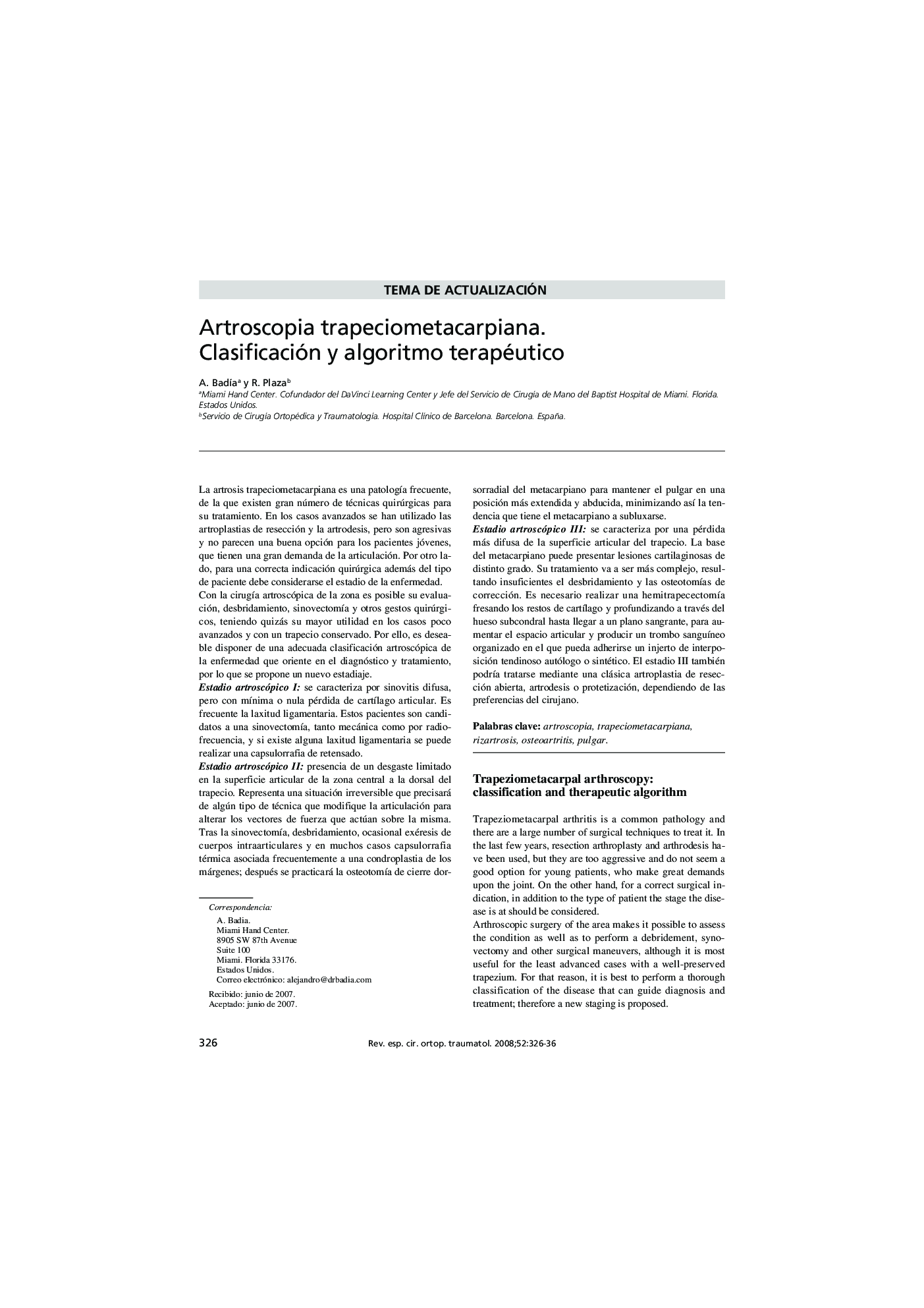| Article ID | Journal | Published Year | Pages | File Type |
|---|---|---|---|---|
| 4086670 | Revista Española de Cirugía Ortopédica y Traumatología | 2008 | 11 Pages |
La artrosis trapeciometacarpiana es una patología frecuente, de la que existen gran número de técnicas quirúrgicas para su tratamiento. En los casos avanzados se han utilizado las artroplastias de resección y la artrodesis, pero son agresivas y no parecen una buena opción para los pacientes jóvenes, que tienen una gran demanda de la articulación. Por otro lado, para una correcta indicación quirúrgica además del tipo de paciente debe considerarse el estadio de la enfermedad. Con la cirugía artroscópica de la zona es posible su evaluación, desbridamiento, sinovectomía y otros gestos quirúrgicos, teniendo quizás su mayor utilidad en los casos poco avanzados y con un trapecio conservado. Por ello, es deseable disponer de una adecuada clasificación artroscópica de la enfermedad que oriente en el diagnóstico y tratamiento, por lo que se propone un nuevo estadiaje.Estadio artroscópico Ise caracteriza por sinovitis difusa, pero con mínima o nula pérdida de cartílago articular. Es frecuente la laxitud ligamentaria. Estos pacientes son candidatos a una sinovectomía, tanto mecánica como por radiofrecuencia, y si existe alguna laxitud ligamentaria se puede realizar una capsulorrafia de retensado.Estadio artroscópico IIpresencia de un desgaste limitado en la superficie articular de la zona central a la dorsal del trapecio. Representa una situación irreversible que precisará de algún tipo de técnica que modifique la articulación para alterar los vectores de fuerza que actúan sobre la misma. Tras la sinovectomía, desbridamiento, ocasional exéresis de cuerpos intraarticulares y en muchos casos capsulorrafia térmica asociada frecuentemente a una condroplastia de los márgenes; después se practicará la osteotomía de cierre dorsorradial del metacarpiano para mantener el pulgar en una posición más extendida y abducida, minimizando así la tendencia que tiene el metacarpiano a subluxarse.Estadio artroscópico IIIse caracteriza por una pérdida más difusa de la superficie articular del trapecio. La base del metacarpiano puede presentar lesiones cartilaginosas de distinto grado. Su tratamiento va a ser más complejo, resultando insuficientes el desbridamiento y las osteotomías de corrección. Es necesario realizar una hemitrapecectomía fresando los restos de cartílago y profundizando a través del hueso subcondral hasta llegar a un plano sangrante, para aumentar el espacio articular y producir un trombo sanguíneo organizado en el que pueda adherirse un injerto de interposición tendinoso autólogo o sintético. El estadio III también podría tratarse mediante una clásica artroplastia de resección abierta, artrodesis o protetización, dependiendo de las preferencias del cirujano.
Trapeziometacarpal arthritis is a common pathology and there are a large number of surgical techniques to treat it. In the last few years, resection arthroplasty and arthrodesis have been used, but they are too aggressive and do not seem a good option for young patients, who make great demands upon the joint. On the other hand, for a correct surgical indication, in addition to the type of patient the stage the disease is at should be considered.Arthroscopic surgery of the area makes it possible to assess the condition as well as to perform a debridement, synovectomy and other surgical maneuvers, although it is most useful for the least advanced cases with a well-preserved trapezium. For that reason, it is best to perform a thorough classification of the disease that can guide diagnosis and treatment; therefore a new staging is proposed.Arthroscopic stage Iit is characterized by diffuse synovitis with little or no loss of articular cartilage. Ligament laxity is common. These patients are candidates for either mechanical or RF synovectomy and, if ligament laxity is present, then a retensioning capsulorrhaphy can be performed.Arthroscopic stage IIthere is limited erosion of the joint surface of the central and dorsal areas of the trapezium. This is an irreversible situation that requires some type of technique that can modify the joint by altering the force vectors acting upon it. After synovectomy, a debridement is performed, followed by the occasional excision of intraarticular bodies and, in many cases, a thermal capsulorrhaphy often associated to a chondroplasty of the margins. Subsequently, a dorsoradial closing-wedge metacarpal osteotomy is performed to keep the thumb in a more extended and abducted position, thus minimizing the metacarpal's tend to subluxate.Arthroscopic stage IIIcharacterized by a more diffuse loss of the trapezial joint surface. The base of the metacarpal can present with different types of chondral injuries. Their treatment tends to be complex and debridement and corrective osteotomy are often insufficient. In these cases a hemitrapezectomy is necessary; the remaining cartilage must be removed, reaming through the subchondral bone until a bleeding plane is reached. In this way, the joint space can be increased and an organized blood thrombus be created, where an autologous or synthetic tendinous interposition graft may be attached. Stage III can also be treated by means of a classical open-wedge resection arthroplasty, an arthrodesis or prosthetic implantation, depending on the surgeon's preferences.
